NVIDIA’s GeForce GTS 450: Pushing Fermi In To The Mainstream
by Ryan Smith on September 13, 2010 12:02 AM EST- Posted in
- NVIDIA
- Fermi
- GeForce GTS 450
- GF106
- GPUs
Overclocking
As we alluded to in the opening of this article, NVIDIA is once again pushing the overclockability of their GPUs. The GF106 GPU at the heart of the GTS 450 is supposed to be about as overclockable as the GF104 GPU instead the GTX 460, and there’s little doubt that this is the case. NVIDIA’s partners are already on the bandwagon, and are offering heavily overclocked cards. Or for the do-it-yourself types, even the average reference card should be quite overclockable as long as you’re willing to take the risk of the periodic dud.
The GTS 450 is already supported by the latest version of MSI’s excellent afterburner software, and keeping with their policy MSI has enabled overvoltage support for all cards using the same VRMs as the reference card. So we were able to overvolt all of our reference cards and our factory overclocked cards. The VRMs on all of the cards except the Asus card top out at 1.162v, however for safety reasons (and the fact that the VRMs aren’t even passively cooled) we limited ourselves to 1.15v.
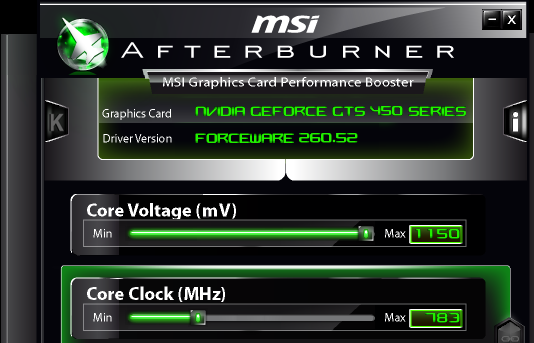
As not all of our cards are exactly alike, we’ll quickly run down the differences between the various cards
- 2x NVIDIA GTS 450 Reference
- 1x Calibre X450G. Reference PCB, aftermarker cooler, factory overclocked
- 1x EVGA GTS 450 FTW. Reference PCB, reference cooler, factory overclocked
- 1x Asus ENGTS450 TOP. Reference-derived PCB, custom cooler, factory overclocked
- 1x Palit GeForce GTS 450 Sonic Platinum. Custom PCB, custom cooler, factory overclocked
| Overclocking Results | ||||||
| Stock Clock | Max Overclock | Stock Voltage | Overclocked Voltage | |||
| GTS 450 Reference #1 | 783MHz | 955MHz | 1.05v | 1.115v | ||
| GTS 450 Reference #2 | 783MHz | 930MHz | 1.062v | 1.115v | ||
| Asus ENGTS450 Top | 925MHz | 985MHz | 1.125v | 1.115v | ||
| EVGA GTS 450 FTW | 920MHz | 955MHz | 1.112v | 1.115v | ||
| Palit GTS 450 Sonic Platinum | 930MHz | 985MHz | 1.087v | 1.115v | ||
| Sparkle Calibre X450G | 850MHz | 935MHz | 1.087v | 1.115v | ||
Unlike the GTX 460 launch where the vendor cards we had all came with a mild factory overclock, for the GTS 450 launch all of our cards have a significant factory overclock. 3 of the 4 are at 920MHz or better, which is a 137MHz (17%) overclock over reference speeds.
Even with voltage tweaking capabilities there was a very noticeable range in the overclockability of our cards. The worst card was one of the reference cards, which only hit 930MHz even at 1.15v. The best cards were the Asus and Palit cards at 985MHz. This puts the average overclock at just over 955MHz, which isn’t too far off from the factory overclocks already on some of these cards.
Meanwhile 4.2GHz seems to be the wall for memory overclocking. The GTS 450 is only equipped with 4GHZ GDDR5, so this may not be a fantastic outcome but it is realistic.

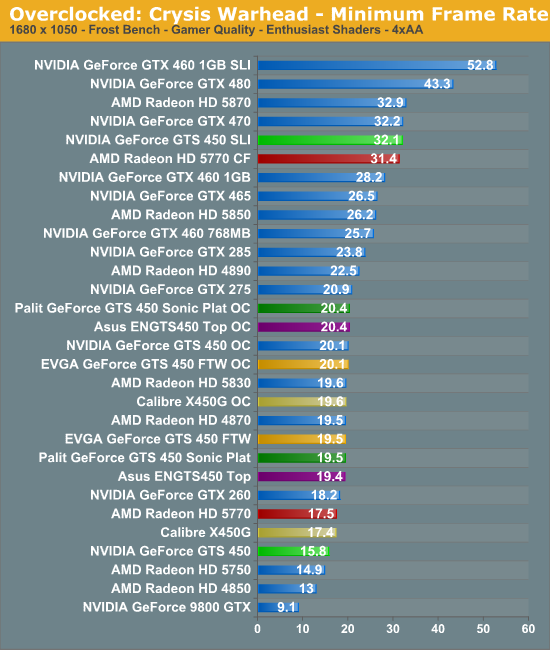
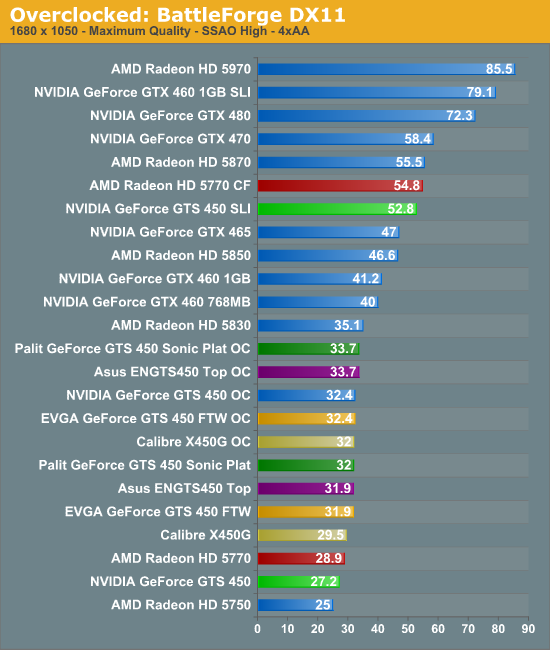
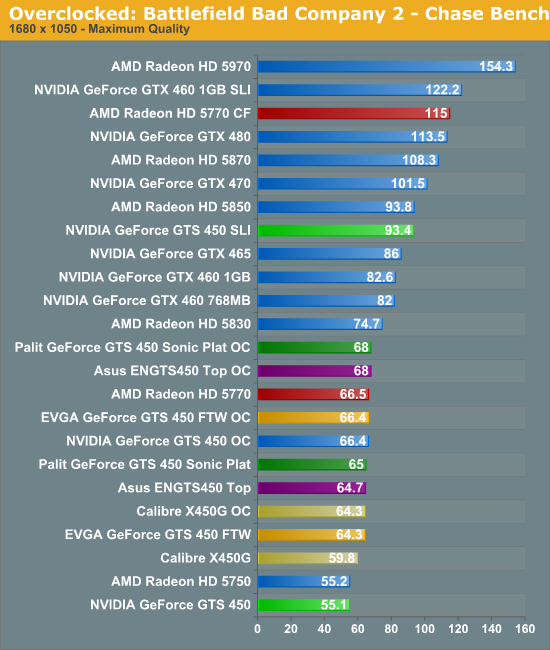
Because our maximum overclocks weren’t too much higher than the factory overclocks on some of these cards, there aren’t many surprises to be had when it comes to overclocking. With a solid overclock you can beat the 5770 most of the time, but it’s not enough to get much higher than that.
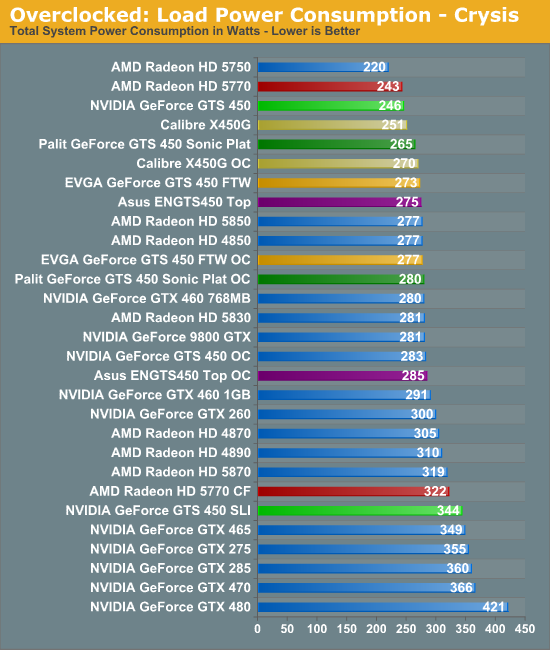
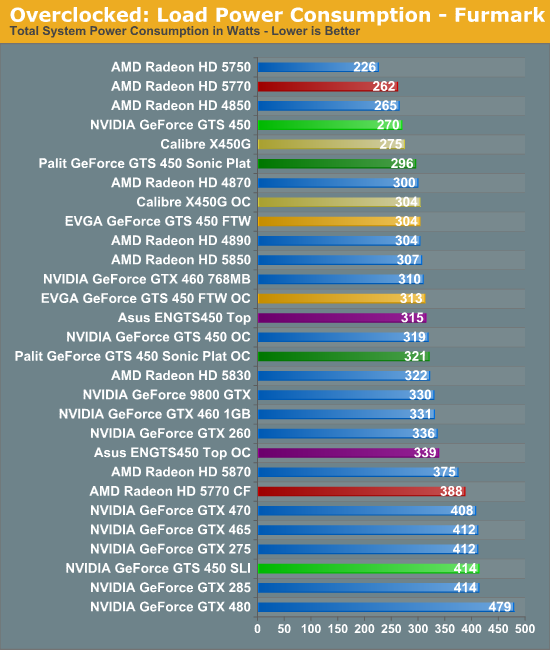

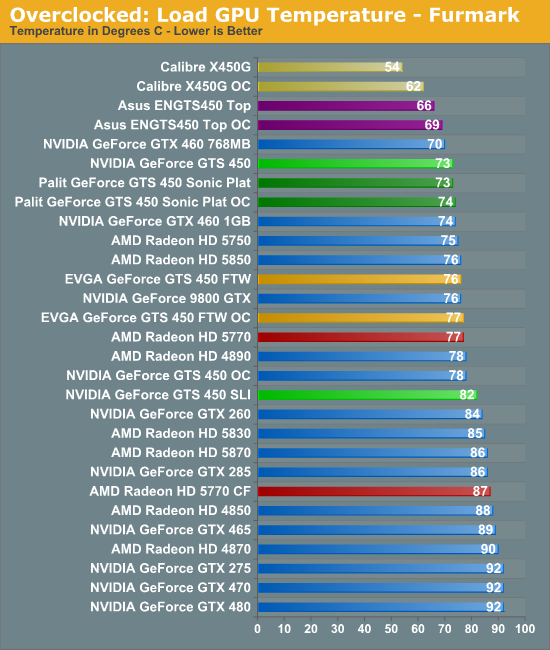

Overclocking (or rather overvolting) has the usual outcome when we look at power, temperature, and noise. The extra power enables extra performance, but it completely blows the performance-per-watt of the GTS 450 cards. Temperature and noise levels rise, but both are actually still quite manageable even at 1.15v. The only things holding the GPU back are the VRMs feeding it, and the innate limits of what the GPU can reach. Given this, it makes little sense not to overclock as long as you have a card with a suitable limit.
Finally, as a testament to how poorly a pair of GTS 450s in SLI get along with each other when they’re right next to each other, we weren’t able to get away with overvolting them at all. Even at 1.1v, the covered card would ultimately reach a thermal runaway under FurMark – the fan would max out and the temperature would start climbing in to the 90s. This shouldn’t be an issue with cards that are separated, but overclocking is definitely not on the menu when they’re packed together.










66 Comments
View All Comments
lecaf - Monday, September 13, 2010 - link
Oh my wrong I missed the SLI partsorry
:)
mino - Monday, September 13, 2010 - link
That "SLI" detail ... :)jabber - Monday, September 13, 2010 - link
Buy a 5770 and OC it to 900/1300 like most should out of the box.Sorted.
Quidam67 - Saturday, September 18, 2010 - link
Agreed. The article repeatedly pointed out that an overclocked 450 catches up to a 5770, but never mentions that the 5770 generally overclocks very well so is likely to take back the lead anyway.Zokudu - Monday, September 13, 2010 - link
But it goes without saying that modern video drivers from both AMD and NVIDIA ridiculously huge, and this new installer doesn’t do anything to change that.I think your missing an are there. Otherwise wonderful article guys.
Lonyo - Monday, September 13, 2010 - link
Well, that whole bit isn't entirely accurate anyway. The NV drivers are more than 2x the size of AMD drivers, and AMD drivers aren't that much bigger than the drivers for more "mundane" things like ever printers and sound cards.Either way it's not entirely relevant at all.
iwodo - Monday, September 13, 2010 - link
Well Nv Drivers includes a lot more then ATI, otherwise they are about the same.But would Anandtech go on to find out just why Drivers Size is so huge. I have the feeling if the drivers were specifically written for one generation of graphics card it would save huge amount of space.
Taft12 - Monday, September 13, 2010 - link
I agree that there is probably a ton of code in there to support cards all the way back to 6xxx but also that this would lead to a support nightmare for users that don't know what model is in their PC.Too bad, but it's the nature of the industry and graphics tech is the fastest moving of them all.
Ryan Smith - Monday, September 13, 2010 - link
Actually we did something a bit like that early last year for the NV drivers.http://www.anandtech.com/show/3510
At the time the PhysX package was around 40% of the required space.
On modern drivers the languages have a lot to do with it. The NV International drivers are a good 30MB bigger than the English-only drivers.
heflys - Monday, September 13, 2010 - link
This card is such a disappointment. It performs worse than the year old card 5770, and only surpasses it when overclocked; it's also about the same price. Furthermore, in some reviews, the 5770 even beats it in Crossfire vs SLI comparison! To add further insult to injury, AMD is about to launch new cards shortly!This card has to be priced at $110-120 to be competitive in my book.